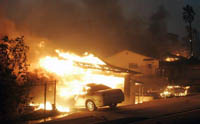Calif. firefighters given hope that worst blazes gone

Thousands of homes are in danger in California as flames get closer. Despite a break in the harsh winds and a massive aerial assault many people don’t hope they will return to their homes soon.
You may see here the photos from struggling California.
The hot, dry Santa Ana winds that have whipped the blazes into a destructive, indiscriminate fury since the weekend were expected to all but disappear Thursday.
"That will certainly aid in firefighting efforts," National Weather Service meteorologist Jamie Meier said.
The record high temperatures of recent days began succumbing to cooling sea breezes, and two fires that burned 21 homes in northern Los Angeles County were fully contained.
Even with the slackening winds, the county remains a tinderbox. Firefighters cut fire lines around the major blazes in San Diego County, but none of the four fires was more than 40 percent contained. More than 8,500 homes were still threatened.
President George W. Bush, who has declared a major disaster in a seven-county region, was scheduled to arrive in California on Thursday and to take an aerial tour of the burn areas, accompanied by Gov. Arnold Schwarzenegger.
Memories still linger of the U.S. government's failed response Hurricane Katrina and how it hurt Bush's standing. The tricky matter of when to time a presidential tour - one that itself commands state and local resources - was one the White House had to work through.
"It's a sad situation out there in Southern California," Bush said outside the White House before leaving for California. "I fully understand that the people have got a lot of anguish in their hearts. They just need to know a lot of folks care about them."
Towns scattered throughout the county remained on the edge of disaster, including the apple-picking region around Julian, where dozens of homes burned in 2003.
To the northeast, in the San Bernardino County mountain resort of Lake Arrowhead, fire officials said 6,000 homes remained in the path of two wildfires that had destroyed more than 300 homes.
Both fires remained out of control, but were being bombarded by aerial tankers and helicopters that dumped more than 30 loads of water.
Losses total at least $1 billion (EUR700 million) in San Diego County alone, and include a third of the state's avocado crop. The losses are half as high as those in Southern California's 2003 fires, but are certain to rise.
The more hopeful news on the fire lines came a day after residents in some hard-hit San Diego County neighborhoods were allowed backtotheir streets, many lined with the wreckage of melted cars.
In upscale Rancho Bernardo, house after house had been reduced to a smoldering heap. Cheryl Monticello, 38 and eight months pregnant, knew what she would find when she came back Wednesday because a city official warned her the house was lost. But she had to see it for herself.
"You really need to see it to know for sure," Monticello said.
Only the white brick chimney and her daughter's backyard slide had survived the inferno that bore down on her neighborhood Monday morning.
As nature's blitzkrieg starts to recede, many of the other refugees will be allowed back to their neighborhoods. More than 500,000 people were evacuated in San Diego County alone, part of the largest mass evacuation in California history.
So far, at least 15 fires have destroyed about 1,500 homes since they began late Saturday.
The burn area of nearly 460,000 acres (186,160 hectares) stretches in a broad arc from Ventura County north of Los Angeles east to the San Bernardino National Forest and south to the U.S.-Mexico border.
In the middle of that arc, the Santiago Fire in Orange County had burned nearly 20,000 acres (8,094 hectares) and destroyed nine homes. Only 50 percent contained, it is a suspected arson fire.
"Whoever has started this has started it at different points that indicated that they wanted it to grow rapidly," Kris Concepion, an Orange County fire battalion chief, told CNN Thursday morning.
Agents from the FBI and the federal Bureau of Alcohol, Tobacco, Firearms and Explosives were sent to help investigate. Authorities said a smaller, more recent fire in Riverside County also is linked to arson.
Despite the widespread destruction, the fires have directly claimed just one life, 52-year-old Thomas Varshock of Tecate. The San Diego medical examiner's office listed five other deaths as connected to the blazes because all who died were evacuees.
The number of victims could rise as authorities return to neighborhoods where homes burned. In 2003, 22 people lost their lives in a series of fires that lasted nearly two weeks.
Terry Dooley, who was ordered out of his San Bernardino home with his wife and three sons Monday, said authorities learned important lessons from Hurricane Katrina and the 2003 fires.
Unlike many of the poor neighborhoods flooded by Hurricane Katrina, some of California's hardest-hit areas were filled with upscale homes, with easy access and wide streets. Authorities used reverse 911 calls to warn residents to get out.
Subscribe to Pravda.Ru Telegram channel, Facebook, RSS!


